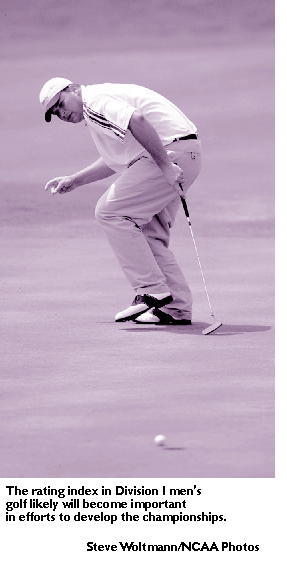The NCAA News - News and FeaturesApril 6, 1998
An Evolving Championship
Committee hopes experimentation with rating index in Division I men's golf ultimately will play role in development, improvement of event
BY SHAWNA HANSEN
STAFF WRITER
Not many people may be aware that NCAA Division I men's golf includes a rating index as part of the criteria for selection of teams for regional championships.
 But that index likely will become better known -- and more important -- as the Division I Men's and Women's Golf Committee develops the men's championships. But that index likely will become better known -- and more important -- as the Division I Men's and Women's Golf Committee develops the men's championships.
The committee currently is using eight different computer models, each employing slightly different criteria for evaluation, said William T. "Todd" Turner, athletics director at Vanderbilt and a member of the committee.
"The rating of the teams is additional information the committee uses in making selections and seeding," Turner said.
The three variables used in the models are strength of field, scoring average and cumulative performance.
"The indexes are a means of coordinating as many variables as you can put into a computer," said committee member George Michael Griffin, head men's golf coach at Auburn University.
Are eight models too many? The committee believes it needs a few years to answer that question. "I don't know if one formula is the best," Griffin said, " but together they seem to work well."
Of course, some things -- like injuries or lineup changes -- can't always be accounted for in a computer.
"The computer program crunches the numbers efficiently, but the committee analyzes and makes the final decision," said committee member Robert E. "Bob" Livingstone, head coach at Long Beach State University. "Human interpretation of the information the committee gathers is most important."
The committee also considers head-to-head results, stroke differential, won-lost record and strength of schedule when making selections and seedings.
"The concern of the coaching body is that (the rating index) is equitable and it's used correctly so teams do not slip through the cracks," Griffin said.
Although the index is just one of several things the committee considers in selecting championships participants, committee members foresee it playing an important role in efforts to expand and improve the event.
"The committee is working on an ideal championship," Turner said.
With that objective in mind, the committee has set three goals:
Provide as many opportunities as possible for student-athletes to participate in the championship.
Structure the tournament so it is fair and can be managed efficiently.
Promote the sport of intercollegiate men's golf.
Turner believes one way to accomplish these goals is to expand the field to accommodate automatic qualifiers (for example, granting automatic berths to conference champions).
This, in turn, could increase field sizes at regionals and ultimately result in an increase in the number of regional tournaments, from three to four.
In that scenario, the golf committee anticipates using the rating index to balance the field -- much like basketball -- and teams even may be seeded within each region
This spring, the committee will consider expanding the number of teams in each of the three current regions.
"Developing an ideal championship takes time," Turner said. "We have a great championship now. We want to move deliberately and the rating index would assist that."
But the index never will be a substitute for actually competing on the links.
"Pepperdine won last year and was back in the pack, according to the polls and ratings -- so they don't determine everything," Griffin said. "Because you still have to go out and play the game."
|